ED Decision 2022/006/R
(a) Signs should be either fixed message signs or variable message signs.
(b) Applicability:
(1) Signs should be provided to convey a mandatory instruction, information on a specific location, or destination on a movement area or to provide other information necessary for the implementation of surface movement guidance and control system (SMGCS) at an aerodrome.
(2) A variable message sign should be provided where:
(i) the instruction or information displayed on the sign is relevant only during a certain period of time; and/or
(ii) there is a need for variable predetermined information to be displayed on the sign to meet the requirements of the implementation of surface movement guidance and control system (SMGCS) at an aerodrome.
(c) Characteristics:
(1) Signs should be frangible. Those located near a runway or taxiway should be sufficiently low to preserve clearance for propellers and the engine pods of jet aircraft. The installed height of the sign should not exceed the dimension shown in the appropriate column of Table N-1.
(2) Signs should be rectangular, as shown in Figures N-4 and N-6 with the longer side horizontal.
(3) The only signs on the movement area utilising red should be mandatory instruction signs.
(4) Signs should be illuminated when intended for use:
(i) in runway visual range conditions less than a value of 800 m; or
(ii) at night in association with instrument runways; or
(iii) at night in association with non-instrument runways where the code number is 3 or 4.
(5) Signs should be retroreflective and/or illuminated when intended for use at night in association with non-instrument runways where the code number is 1 or 2.
(6) Where variable pre-determined information is required, a variable sign should be provided.
(i) A variable message sign should show a blank face when not in use.
(ii) In case of failure, a variable message sign should not provide information that could lead to unsafe action from a pilot or a vehicle driver.
(iii) The time interval to change from one message to another on a variable message sign should be as short as practicable and should not exceed 5 seconds.
(7) The taxiing guidance signs should be in accordance with the specifications of paragraphs (c)(8) to (c)(22).
(8) The location distance for taxiing guidance signs including runway exit signs should conform to Table N-1.
|
Sign height (mm) |
Perpendicular distance from defined taxiway pavement edge to near side of sign |
Perpendicular distance from defined runway pavement edge to near side of sign |
|||
|
Runway code number |
Legend |
Face (min) |
Installed (max) |
||
|
1 or 2 |
200 |
400 |
700 |
5–11 m |
3–10 m |
|
1 or 2 |
300 |
600 |
900 |
5–11 m |
3–10 m |
|
3 or 4 |
300 |
600 |
900 |
11–21 m |
8–15 m |
|
3 or 4 |
400 |
800 |
1 100 |
11–21 m |
8–15 m |
Table N-1. Location distances for taxiing guidance signs including runway exit signs
(9) Inscription heights should conform to the Table N-2.
|
Runway code number |
Minimum character height |
||
|
Mandatory instruction sign |
Information sign |
||
|
Runway exit and runway vacated signs |
Other signs |
||
|
1 or 2 |
300 mm |
300 mm |
200 mm |
|
3 or 4 |
400 mm |
400 mm |
300 mm |
Table N-2. Minimum character height
(10) Where a taxiway location sign is installed in conjunction with a runway designation sign (see CS ADR-DSN.N.785(b)(9)), the character size should be that specified for mandatory instruction signs.
(11) The dimensions should be as follows for:
(i) Arrow:
|
Legend height |
Stroke |
|
200 mm |
32 mm |
|
300 mm |
48 mm |
|
400 mm |
64 mm |
(ii) Stroke:
|
Legend height |
Stroke |
|
200 mm |
32 mm |
|
300 mm |
48 mm |
|
400 mm |
64 mm |
(12) Sign luminance should be as follows:
(i) Where operations are conducted in runway visual range conditions less than a value of 800 m, average sign luminance should be at least:
|
Red |
30 cd/m2 |
|
Yellow |
150 cd/m2 |
|
White |
300 cd/m2 |
(ii) Where operations are conducted in accordance with CS ADR-DSN.N.775(c)(4)(ii) and (c)(5), average sign luminance should be at least:
|
Red |
10 cd/m2 |
|
Yellow |
50 cd/m2 |
|
White |
100 cd/m2 |
Note: In runway visual range conditions less than a value of 400 m, there will be some degradation in the performance of signs.
(13) The luminance ratio between red and white elements of a mandatory instruction sign should be between 1:5 and 1:10.
(14) The average luminance of the sign is calculated by establishing grid points as shown in Figure N-1, and using the luminance values measured at all grid points located within the rectangle representing the sign.
(15) The average value is the arithmetic average of the luminance values measured at all considered grid points.
(16) The ratio between luminance values of adjacent grid points should not exceed 1.5:1. For areas on the sign face where the grid spacing is 7.5 cm, the ratio between luminance values of adjacent grid points should not exceed 1.25:1. The ratio between the maximum and minimum luminance value over the whole sign face should not exceed 5:1.
(17) The forms of characters, i.e. letters, numbers, arrows, and symbols should conform to those shown in Figures N-2A to N-2H. The width of characters and the space between individual characters should be determined as indicated in Table N-3.
(18) The face height of signs should be as follows:
|
Legend height |
Face height (min) |
|
200 mm |
400 mm |
|
300 mm |
600 mm |
|
400 mm |
800 mm |
(19) The face width of signs should be determined using Figure N-3 except that, where a mandatory instruction sign is provided on one side of a taxiway only, the face width should not be less than:
(i) 1.94 m where the code number is 3 or 4; and
(ii) 1.46 m where the code number is 1 or 2.
(20) Borders:
(i) The black vertical delineator between adjacent direction signs should have a width of approximately 0.7 of the stroke width.
(ii) The yellow border on a stand-alone location sign should be approximately 0.5 stroke width.
(21) The colours of signs should be in accordance with the appropriate specifications in CHAPTER U — Colours for aeronautical ground lights, markings, signs and panels.
(22) If the runway threshold is displaced from the extremity of the runway, a sign showing the designation of the runway may be provided for aeroplanes taking off.

Note 1: The average luminance of a sign is calculated by establishing grid points on a sign face showing typical inscriptions and a background of the appropriate colour (red for mandatory instruction signs and yellow for direction and destination signs) as follows:
(a) Starting at the top left corner of the sign face, establish a reference grid point at 7.5 cm from the left edge and the top of the sign face.
(b) Create a grid of 15 cm spacing horizontally and vertically from the reference grid point. Grid points within 7.5 cm of the edge of the sign face should be excluded.
(c) Where the last point in a row/column of grid points is located between 22.5 cm and 15 cm from the edge of the sign face (but not inclusive), an additional point should be added 7.5 cm from this point.
(d) Where a grid point falls on the boundary of a character and the background, the grid point should be slightly shifted to be completely outside the character.
Note 2: Additional grid points may be required to ensure that each character includes at least five evenly spaced grid points.
Note 3: Where one unit includes two types of signs, a separate grid should be established for each type.
Figure N-1. Grid points for calculating average luminance of a sign

Figure N-2A. Forms of characters for signs
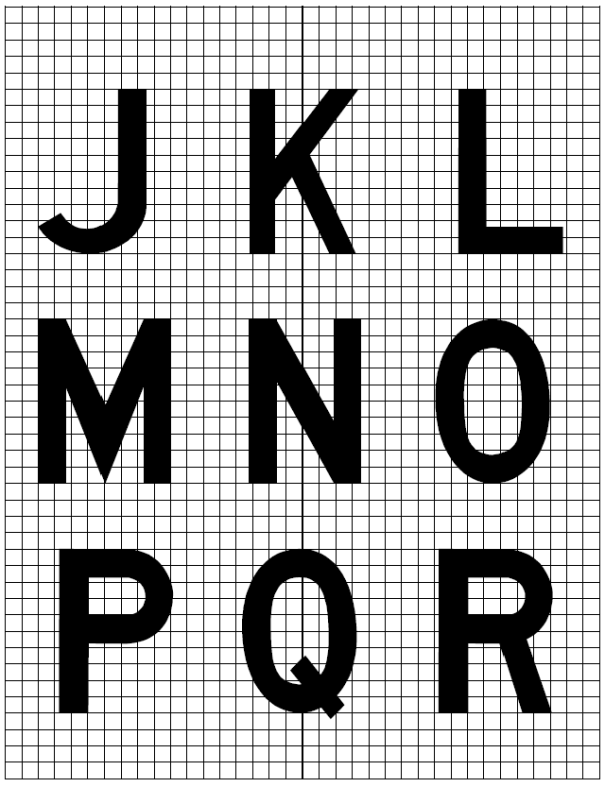
Figure N-2B. Forms of characters for signs
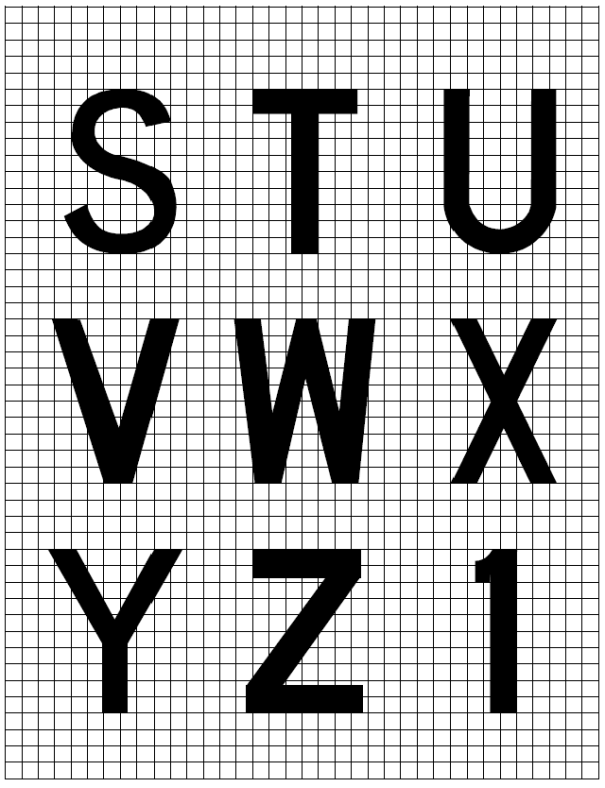
Figure N-2C. Forms of characters for signs

Figure N-2D. Forms of characters for signs

Figure N-2E. Forms of characters for signs

Figure N-2F. Runway vacated sign with typical location sign
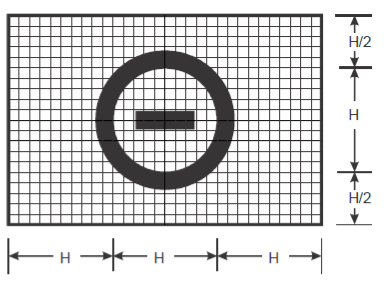
Figure N-2G. No-entry sign
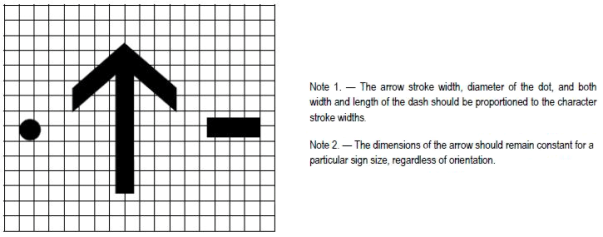
Figure N-2H. Forms of characters for signs

Figure N-3. Sign dimensions
|
a) Letter to letter code number |
|||
|
Preceding Letter |
Following Letter |
||
|
B, D, E, F, H, I, K, L, M, N, P, R, U |
C, G, O, Q, S, X, Z |
A, J, T, V, W, Y |
|
|
Code number |
|||
|
A |
2 |
2 |
4 |
|
B |
1 |
2 |
2 |
|
C |
2 |
2 |
3 |
|
D |
1 |
2 |
2 |
|
E |
2 |
2 |
3 |
|
F |
2 |
2 |
3 |
|
G |
1 |
2 |
2 |
|
H |
1 |
1 |
2 |
|
I |
1 |
1 |
2 |
|
J |
1 |
1 |
2 |
|
K |
2 |
2 |
3 |
|
L |
2 |
2 |
4 |
|
M |
1 |
1 |
2 |
|
N |
1 |
1 |
2 |
|
O |
1 |
2 |
2 |
|
P |
1 |
2 |
2 |
|
Q |
1 |
2 |
2 |
|
R |
1 |
2 |
2 |
|
S |
1 |
2 |
2 |
|
T |
2 |
2 |
4 |
|
U |
1 |
1 |
2 |
|
V |
2 |
2 |
4 |
|
W |
2 |
2 |
4 |
|
X |
2 |
2 |
3 |
|
Y |
2 |
2 |
4 |
|
Z |
2 |
2 |
3 |
|
b) Numeral to numeral code number |
|||
|
Preceding Numeral |
Following number |
||
|
1, 5 |
2, 3, 6, 8, 9, 0 |
4, 7 |
|
|
Code number |
|||
|
1 |
1 |
1 |
2 |
|
2 |
1 |
2 |
2 |
|
3 |
1 |
2 |
2 |
|
4 |
2 |
2 |
4 |
|
5 |
1 |
2 |
2 |
|
6 |
1 |
2 |
2 |
|
7 |
2 |
2 |
4 |
|
8 |
1 |
2 |
2 |
|
9 |
1 |
2 |
2 |
|
0 |
1 |
2 |
2 |
|
c) Space between characters |
|||
|
Code No. |
Character height (mm) |
||
|
200 |
300 |
400 |
|
|
Space (mm) |
|||
|
1 |
48 |
71 |
96 |
|
2 |
38 |
57 |
76 |
|
3 |
25 |
38 |
50 |
|
4 |
13 |
19 |
26 |
|
d) Width of letter |
|||
|
Letter |
Letter height (mm) |
||
|
200 |
300 |
400 |
|
|
Width (mm) |
|||
|
A |
170 |
255 |
340 |
|
B |
137 |
205 |
274 |
|
C |
137 |
205 |
274 |
|
D |
137 |
205 |
274 |
|
E |
124 |
186 |
248 |
|
F |
124 |
186 |
248 |
|
G |
137 |
205 |
274 |
|
H |
137 |
205 |
274 |
|
I |
32 |
48 |
64 |
|
J |
127 |
190 |
254 |
|
K |
140 |
210 |
280 |
|
L |
124 |
186 |
248 |
|
M |
157 |
236 |
314 |
|
N |
137 |
205 |
274 |
|
O |
143 |
214 |
286 |
|
P |
137 |
205 |
274 |
|
Q |
143 |
214 |
286 |
|
R |
137 |
205 |
274 |
|
S |
137 |
205 |
274 |
|
T |
124 |
186 |
248 |
|
U |
137 |
205 |
274 |
|
V |
152 |
229 |
304 |
|
W |
178 |
267 |
356 |
|
X |
137 |
205 |
274 |
|
Y |
171 |
257 |
342 |
|
Z |
137 |
205 |
274 |
|
e) Width of numeral |
|||
|
Numeral |
Numeral height (mm) |
||
|
200 |
300 |
400 |
|
|
Width (mm) |
|||
|
1 |
50 |
74 |
98 |
|
2 |
137 |
205 |
274 |
|
3 |
137 |
205 |
274 |
|
4 |
149 |
224 |
298 |
|
5 |
137 |
205 |
274 |
|
6 |
137 |
205 |
274 |
|
7 |
137 |
205 |
274 |
|
8 |
137 |
205 |
274 |
|
9 |
137 |
205 |
274 |
|
0 |
143 |
214 |
286 |
INSTRUCTIONS
1. To determine the proper SPACE between letters or numerals, obtain the code number from table a) or b) and enter table c) for that code number to the desired letter or numeral height.
2. The space between words or groups of characters forming an abbreviation or symbol should be equal to 0.5 to 0.75 of the height of the characters used except that where an arrow is located with a single character such as ‘A→‘, the space may be reduced to not less than one quarter of the height of the character in order to provide a good visual balance.
3. Where the numeral follows a letter or vice versa, use Code 1.
4. Where a hyphen, dot, or diagonal stroke follows a character or vice versa, use Code 1.
5. For the intersection take-off sign, the height of the lower case ‘m’ is 0.75 of the height of the preceding character. The spacing from the preceding character is at Code 1 for the character height in Table N-3(c).
Table N-3. Letter and numeral width and space between letters or numerals
[Issue: ADR-DSN/3]
[Issue: ADR-DSN/4]
[Issue: ADR-DSN/6]
ED Decision 2022/006/R
(a) Signs may need to be orientated to improve readability.
(b) Guidance on signs is contained in ICAO Doc 9157, Aerodrome Design Manual, Part 4, Visual Aids, Chapter 11.
(c) Guidance on frangibility is contained in ICAO Doc 9157, Aerodrome Design Manual, Part 6, Frangibility.
(d) Guidance on measuring the average luminance of a sign is contained in ICAO Doc 9157, Aerodrome Design Manual, Part 4, Visual Aids.
[Issue: ADR-DSN/3]
[Issue: ADR-DSN/6]
CS ADR-DSN.N.780 Mandatory instruction signs
ED Decision 2022/006/R
(a) Applicability:
(1) A mandatory instruction sign should be provided to identify a location beyond which an aircraft taxiing or vehicle should not proceed unless authorised by the aerodrome control tower.
(2) Mandatory instruction signs should include runway designation signs, Category I, II, or III holding position signs, runway-holding position signs, road-holding position signs, and no‑entry signs.
(3) A pattern ‘A’ runway-holding position marking should be supplemented at a taxiway/runway intersection or a runway/runway intersection with a runway designation sign.
(4) A pattern ‘B’ runway-holding position marking should be supplemented with a Category I, II, or III holding position sign.
(5) A pattern ‘A’ runway-holding position marking at a runway-holding position should be supplemented with a runway-holding position sign.
(6) A runway designation sign at a taxiway/runway intersection should be supplemented with a location sign in the outboard (farthest from the taxiway) position as appropriate.
(7) A road-holding position sign should be provided at all road entrances to a runway and may also be provided at road entrances to taxiways.
(8) A no-entry sign should be provided when entry into an area is prohibited.
(b) Location:
(1) A runway designation sign at a taxiway/runway intersection or a runway/runway intersection should be located on each side of the runway-holding position marking facing the direction of approach to the runway.
(2) A Category I, II, or III holding position sign should be located on each side of the runway-holding position marking facing the direction of the approach to the critical area.
(3) A no-entry sign should be located at the beginning of the area to which entrance is prohibited on each side of the taxiway as viewed by the pilot.
(4) A runway-holding position sign should be located on each side of the runway-holding position facing the approach to the obstacle limitation surface or ILS/MLS critical/sensitive area as appropriate.
(c) Characteristics:
(1) A mandatory instruction sign should consist of an inscription in white on a red background. Where, owing to environmental or other factors, the conspicuity of the inscription on a mandatory instruction sign needs to be enhanced, the outside edge of the white inscription should be supplemented by a black outline measuring 10 mm in width for runway code numbers 1 and 2, and 20 mm in width for runway code numbers 3 and 4.
(2) The inscription on a runway designation sign should consist of the runway designations of the intersecting runway properly oriented with respect to the viewing position of the sign, except that a runway designation sign installed in the vicinity of a runway extremity may show the runway designation of the concerned runway extremity only.
(3) The inscription on a Category I, II, III, joint II/III or joint I/II/III holding position sign should consist of the runway designator followed by CAT I, CAT II, CAT III, CAT II/III or CAT I/II/III, as appropriate.
(4) The inscription on a no-entry sign should be in accordance with Figure N-4.
(5) The inscription on a runway-holding position sign at a runway-holding position should consist of the taxiway designation and a number.
(d) Where installed, the inscriptions/symbol of Figure N-4 should be used:
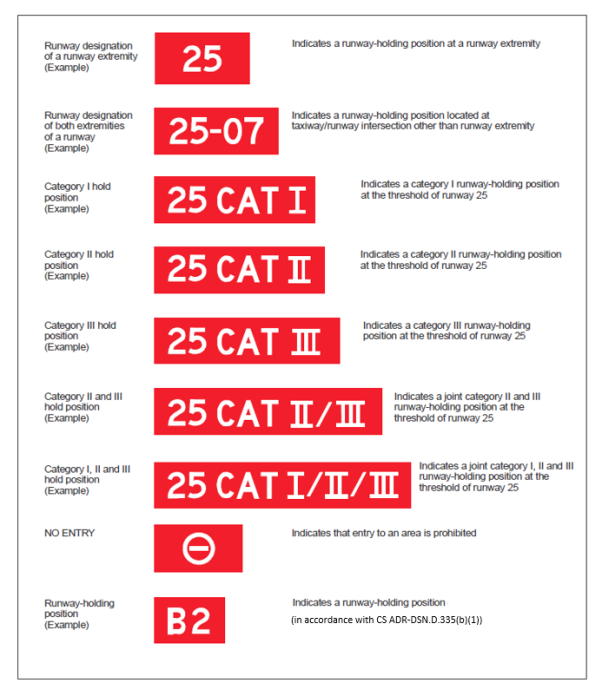
Figure N-4. Mandatory instruction signs

Note: Distance X is established in accordance with Table D-2. Distance Y is established at the edge of ILS/MLS critical/sensitive area
Figure N-5. Positions of signs at taxiway/runway intersections
[Issue: ADR-DSN/3]
[Issue: ADR-DSN/4]
[Issue: ADR-DSN/6]
CS ADR-DSN.N.785 Information signs
ED Decision 2022/006/R
(a) Applicability:
(1) An information sign should be provided where there is an operational need to identify by a sign, a specific location, or routing (direction or destination) information.
(2) Information signs should include: direction signs, location signs, destination signs, runway exit signs, runway vacated signs, and intersection take-off signs.
(3) A runway exit sign should be provided where there is an operational need to identify a runway exit.
(4) A runway vacated sign should be provided where the exit taxiway is not provided with taxiway centre line lights and there is a need to indicate to a pilot leaving a runway the perimeter of the ILS/MLS critical/sensitive area, or the lower edge of the inner transitional surface whichever is farther from the runway centre line.
(5) At runways where intersection take-offs are conducted, an intersection take-off sign should be provided to indicate the remaining take-off run available (TORA) for such take-offs.
(6) Where necessary, a destination sign should be provided to indicate the direction to a specific destination on the aerodrome, such as cargo area, general aviation, etc.
(7) A combined location and direction sign should be provided when it is intended to indicate routing information prior to a taxiway intersection.
(8) A direction sign should be provided when there is an operational need to identify the designation and direction of taxiways at an intersection.
(9) A location sign should be provided at an intermediate holding position.
(10) A location sign should be provided in conjunction with a runway designation sign except at a runway/runway intersection.
(11) A location sign should be provided in conjunction with a direction sign, except that it may be omitted where a safety assessment indicates that it is not needed.
(12) Where necessary, a location sign should be provided to identify taxiways exiting an apron or taxiways beyond an intersection.
(13) Where a taxiway ends at an intersection such as a ‘T’ and it is necessary to identify this, a barricade, direction sign, and/or other appropriate visual aid should be used.
(b) Location:
(1) Except as specified in paragraph (b)(3) below, information signs should wherever practicable, be located on the left-hand side of the taxiway in accordance with Table N-1.
(2) At a taxiway intersection, information signs should be located prior to the intersection and in line with the intermediate holding position marking. Where there is no intermediate holding position marking, the signs should be installed at least 60 m from the centre line of the intersecting taxiway where the code number is 3 or 4, and at least 40 m where the code number is 1 or 2.
(3) A runway exit sign should be located on the same side of the runway as the exit is located (i.e. left or right), and positioned in accordance with Table N-1.
(4) A runway exit sign should be located prior to the runway exit point in line with a position at least 60 m prior to the point of tangency where the code number is 3 or 4, and at least 30 m where the code number is 1 or 2.
(5) A runway vacated sign should be located at least on one side of the taxiway. The distance between the sign and the centre line of a runway should be not less than the greater of the following:
(i) the distance between the centre line of the runway and the perimeter of the ILS/MLS critical/sensitive area; or
(ii) the distance between the centre line of the runway and the lower edge of the inner transitional surface.
(6) Where provided in conjunction with a runway vacated sign, the taxiway location sign should be positioned outboard of the runway vacated sign.
(7) An intersection take-off sign should be located at the left-hand side of the entry taxiway. The distance between the sign and the centre line of the runway should be not less than 60 m where the code number is 3 or 4 and not less than 45 m where the code number is 1 or 2.
(8) A taxiway location sign installed in conjunction with a runway designation sign should be positioned outboard of the runway designation sign.
(9) A destination sign should not normally be collocated with a location or direction sign.
(10) An information sign other than a location sign should not be collocated with a mandatory instruction sign.
(c) Characteristics:
(1) An information sign other than a location sign should consist of an inscription in black on a yellow background.
(2) A location sign should consist of an inscription in yellow on a black background and where it is a stand-alone sign, should have a yellow border.
(3) The inscription on a runway exit sign should consist of the designator of the exit taxiway and an arrow indicating the direction to follow.
(4) The inscription on a runway vacated sign should depict the pattern A runway-holding position marking as shown in Figure N-6.
(5) The inscription on an intersection take-off sign should consist of a numerical message indicating the remaining take-off run available in metres, plus an arrow, appropriately located and oriented, indicating the direction of the take-off as shown in Figure N-6.
(6) The inscription on a destination sign should comprise an alpha, alphanumerical or numerical message identifying the destination, plus an arrow indicating the direction to proceed as shown in Figure N-6.
(7) The inscription on a direction sign should comprise an alpha or alphanumerical message identifying the taxiway(s) , plus an arrow or arrows appropriately oriented as shown in Figure N-6.
(8) The inscription on a location sign should comprise the designation of the location taxiway, runway, or other pavement the aircraft is on or is entering, and should not contain arrows.
(9) Where necessary to identify each of a series of intermediate holding positions on the same taxiway, the location sign should consist of the taxiway designation and a progressive number.
(10) Where a location sign and direction signs are used in combination:
(i) all direction signs related to left turns should be placed on the left side of the location sign and all direction signs related to right turns should be placed on the right side of the location sign, except that where the junction consists of one intersecting taxiway, the location sign may alternatively be placed on the left hand side;
(ii) the direction signs should be placed such that the direction of the arrows departs increasingly from the vertical with increasing deviation of the corresponding taxiway;
(iii) an appropriate direction sign should be placed next to the location sign where the direction of the location taxiway changes significantly beyond the intersection; and
(iv) adjacent direction signs should be delineated by a vertical black line as shown in Figure N-6.
(11) A taxiway should be identified by a designator that is used only once on an aerodrome and comprising a single letter, two letters, or a combination of a letter or letters followed by a number.
(12) When designating taxiways:
(i) the letters I, O, or X should not be used to avoid confusion with the numerals 1, 0, and the closed marking;
(ii) the use of words such as ‘inner’ and ‘outer’ should be avoided wherever possible.
(13) The use of numbers alone on the manoeuvring area should be reserved for the designation of runways.
(14) Apron stand designators should not be the same as taxiway designators.

Figure N-6. Information signs
[Issue: ADR-DSN/3]
[Issue: ADR-DSN/4]
[Issue: ADR-DSN/6]
GM1 ADR-DSN.N.785 Information signs
ED Decision 2016/027/R
(a) When an installation of information sign on the left-hand side is not possible, e.g. due to infrastructural or operational restrictions, an installation on the right-hand side of the taxiway in accordance with the specifications given in Table N-1 may also be acceptable when a safety assessment indicates that it would not adversely affect the safety of operations of aeroplanes.
(b) At a ‘T’ intersection, information signs may be located in the direction of the taxiway centre line to the opposite side of the crossing taxiway when a safety assessment indicates that guidance could be assured under all intended operating conditions and that it would not adversely affect the safety of operations of aeroplanes.
[Issue: ADR-DSN/3]
CS ADR-DSN.N.790 VOR aerodrome checkpoint sign
ED Decision 2014/013/R
When a VOR aerodrome check-point is established, it should be indicated by a VOR aerodrome check-point marking and sign.
(a) Location: A VOR aerodrome check-point sign should be located as near as possible to the check-point and so that the inscriptions are visible from the cockpit of an aircraft properly positioned on the VOR aerodrome check-point marking.
(b) Characteristics:
(1) A VOR aerodrome check-point sign should consist of an inscription in black on a yellow background.
(2) The inscriptions on a VOR check-point sign should be in accordance with one of the alternatives shown in Figure N-7 in which:
|
VOR |
is an abbreviation identifying this as a VOR check-point; |
|
116.3 |
is an example of the radio frequency of the VOR concerned; |
|
147° |
is an example of the VOR bearing, to the nearest degree, which should be indicated at the VOR check-point; and |
|
4.3 NM |
is an example of the distance in nautical miles to a DME collocated with the VOR concerned. |

Figure N-7. VOR aerodrome check-point sign
CS ADR-DSN.N.795 Aircraft stand identification signs
ED Decision 2017/021/R
(a) Applicability: An aircraft stand identification marking should be supplemented with an aircraft stand identification sign where feasible.
(b) Location: An aircraft stand identification sign should be located so as to be clearly visible from the cockpit of an aircraft prior to entering the aircraft stand.
(c) Characteristics: An aircraft stand identification sign should consist of an inscription in black on a yellow background.
[Issue: ADR-DSN/4]
GM1 ADR-DSN.N.795 Aircraft stand identification signs
ED Decision 2014/013/R
intentionally left blank
CS ADR-DSN.N.800 Road-holding position sign
ED Decision 2017/021/R
(a) Applicability: A road-holding position sign should be provided at all road entrances to a runway.
(b) Location: The road-holding position sign should be located 1.5 m from one edge of the road (left or right as appropriate to the local road traffic regulations) at the holding position.
(c) Where a road intersects a taxiway, a suitable sign may be located adjacent to the roadway/taxiway intersection marking 1.5 m from one edge of the road, i.e. left or right as appropriate to the local road traffic regulations.
(d) Characteristics:
(1) A road-holding position sign at an intersection of a road with a runway should consist of an inscription in white on a red background.
(2) The inscription on a road-holding position sign should be in the national language, be in conformity with the local road traffic regulations, and include the following:
(i) a requirement to stop; and
(ii) where appropriate:
(A) a requirement to obtain ATC clearance; and
(B) location designator.
(3) A road-holding position sign intended for night use should be retroreflective or illuminated.
(4) A road-holding position sign at the intersection of a road with a taxiway should be in accordance with the local road traffic regulations for a yield right of way sign or a stop sign.
[Issue: ADR-DSN/4]
